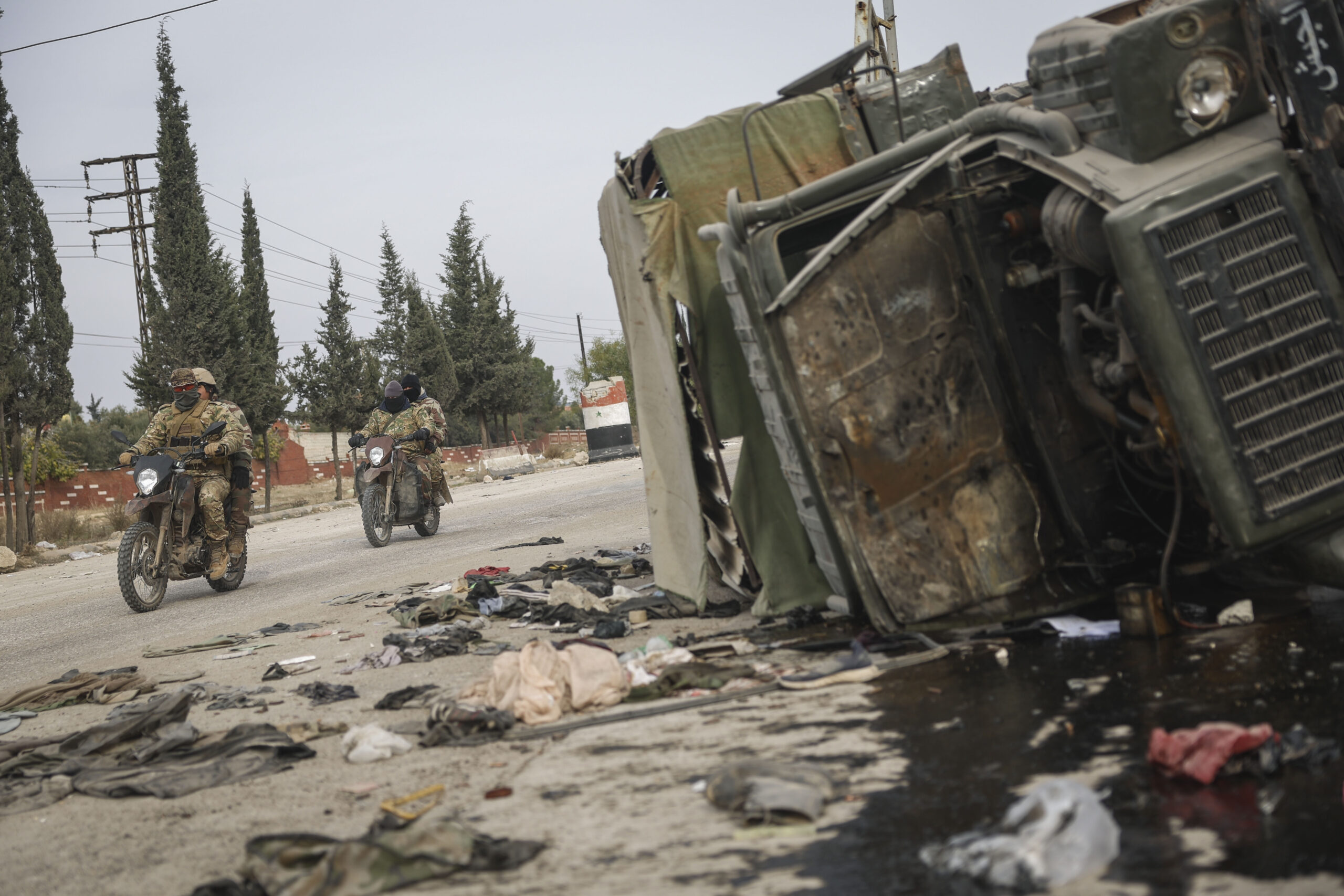
The defence ministry earlier denied rebels had entered Homs, describing the situation there as “safe and stable”.
But the leader of the Islamist Hayat Tahrir al-Sham (HTS) group, Ahmed al-Sharaa, said their control over Homs marked a “historic event that will distinguish between truth and falsehood”.
The capture of Homs, Syria’s third-largest city, would cut the seat of power in the capital Damascus from the Mediterranean coast, a key bastion of the Assad clan which has ruled Syria for the past five decades.
Hassan Abdel Ghani, a leading commander of the Islamist-led rebel coalition, said the group’s “operations continue to fully liberate the Damascus countryside”.
“Our eyes are on the capital, Damascus”, he said on Telegram.
Earlier, President Bashar al-Assad’s government denied the army had withdrawn from areas around Damascus.
“A very strong security and military cordon” was being established around the capital “and no one… can penetrate this defensive line that we, the armed forces, are building,” Interior Minister Mohammed al-Rahmoun told state television.
Homs lies about 140 kilometres (85 miles) north of the capital and is the third major city seized by the rebels who began their advance on November 27, reigniting a years-long war that had become largely dormant.
Rami Abdel Rahman, head of the Britain-based Syrian Observatory for Human Rights, earlier reported rebel factions taking control of some Homs neighbourhoods “after the withdrawal of security forces and the army from their last positions in the city”.
Abdel Ghani said the rebels had freed more than 3,500 detainees from the central prison of Homs.
The defence ministry said “armed forces are deployed around the city, positioned in strong defensive lines reinforced with various types of weapons”.
‘Suddenly everyone was scared’
The HTS leader told fighters to prepare to take the capital.
“Damascus awaits you,” he said on Telegram, using his real name instead of his nom de guerre, Abu Mohammed al-Jolani.
But the defence ministry insisted: “There is no truth to news claiming our armed forces… have withdrawn” from positions near Damascus.
The Syrian army said that, in addition to the area around Damascus, it was reinforcing positions in the south, and operations against the rebels were beginning in the Hama, Homs and Daraa areas.
AFP has been unable to independently verify some of the information provided by the government and the rebels, as its journalists cannot reach the areas around Damascus where the rebels say they are present.
Residents of the capital described to AFP a state of panic as traffic jams clogged the city centre, people sought supplies and queued to withdraw money from ATMs.
“The situation was not like this when I left my house this morning… suddenly everyone was scared,” said one woman, Rania.
A few kilometres (miles) away, the mood was starkly different. In a Damascus suburb, witnesses said protesters toppled a statue of Assad’s father, the late leader Hafez al-Assad.
AFPTV images from Hama, Syria’s fourth-largest city, showed abandoned tanks and other armoured vehicles, one of them on fire.
Hama resident Kharfan Mansour said he was “happy with the liberation of Hama and the liberation of Syria from the Assad regime”.
The president’s office denied reports Assad had left Damascus, saying he was working “from the capital”.
Soldiers ‘fled’ to Iraq
As government forces fall back, the Britain-based Observatory and Abdel Ghani said rebels were within 20 kilometres of Damascus.
The Observatory said government forces had ceded more key ground, losing control of all southern Daraa province, the cradle of the 2011 uprising.
The army said it was “redeploying and repositioning” in Daraa and another southern province, Sweida.
The Observatory also said troops were also evacuating posts in Quneitra, near the Israeli-annexed Golan Heights.
Jordan has urged its citizens to leave neighbouring Syria “as soon as possible”, as have the United States and Assad ally Russia, which both keep troops in Syria.
An AFP correspondent in Daraa saw local fighters guarding public property and civil institutions.
In Sweida, a local fighter told AFP that after government forces withdrew “from their positions and headquarters, we are now securing and protecting vital facilities”.
An Iraqi security source told AFP that Baghdad has allowed in hundreds of Syrian soldiers, who “fled the front lines”, through the Al-Qaim border crossing. A second source put the figure at 2,000 troops, including officers.
‘War, blood and tears’
HTS is rooted in the Syrian branch of Al-Qaeda. Proscribed as a terrorist organisation by Western governments, it has sought to soften its image in recent years, and told minority groups living in areas they now control not to worry.
Since the offensive began, at least 826 people, mostly combatants but also including 111 civilians, have been killed, the Observatory said.
The United Nations said the violence has displaced 370,000 people.
UN special envoy to Syria, Geir Pedersen, called for “urgent political talks” to implement a 2015 Security Council resolution, which set out a roadmap for a negotiated settlement.
US President-elect Donald Trump posted on his Truth Social platform that the United States should “not get involved”, after outgoing US Secretary of State Antony Blinken called Friday for a “political solution to the conflict”, in a call with Turkish Foreign Minister Hakan Fidan.
After Fidan and his Iranian and Russian counterparts discussed Syria in Qatar on Saturday, Iran’s top diplomat Abbas Araghchi said they agreed on the initiation of “political dialogue between the Syrian government and legitimate opposition groups”.
Russian Foreign Minister Sergei Lavrov said it was “inadmissible” to allow a “terrorist group to take control” of Syrian territory.
Moscow and Tehran have supported Assad’s government and army during the war, as has Lebanese armed group Hezbollah.
A source close to Hezbollah said it had sent 2,000 fighters into Syria, to an area near the Lebanese border, “to defend its positions”.
Turkish President Recep Tayyip Erdogan, whose government backs some armed groups in northern Syria, said Saturday that Syria “is tired of war, blood and tears”.
